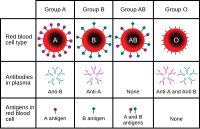
Photo from wikipedia
Purpose The aim of the study was to evaluate the various donor and recipient factors associated with short-term prevalence of surface epithelial keratopathy after optical penetrating keratoplasty (OPK). Methods Preoperative… Click to show full abstract
Purpose The aim of the study was to evaluate the various donor and recipient factors associated with short-term prevalence of surface epithelial keratopathy after optical penetrating keratoplasty (OPK). Methods Preoperative and postoperative data of 91 eyes of 91 patients were reviewed retrospectively who had undergone OPK from March 2013 to February 2016. Donor and recipient data were analyzed for age and sex of the donor, cause of death, death to enucleation time (DET), death to preservation time (DPT), enucleation to utilisation time (EUT) and total time (TT), age and sex of recipient, indications of penetrating keratoplasty (PK), associated glaucoma and recipient size (RS). The presence of various epitheliopathies were recorded at various postoperative visits. Results The range of age of recipient in this study was 10–83 yrs (mean 49.19 ± 19.35 yrs). The donor age ranged in between 17 and 95 years (70.27 ± 15.11 years). Age and preoperative diagnosis of host showed significant influence on epitheliopathy till two weeks and one month post-PK (P = 0.032 and 0.05), respectively. Donor's age and gender showed significant impact on surface keratopathy (SK) till two weeks follow-up with P value of 0.04 and 0.004, respectively. DET, DPT, EUT, and TT affected the surface epithelium significantly with P value of 0.007, 0.001, 0.05, and 0.03, respectively. On first postoperative day 33 (36.26%) eyes developed epithelial defect involving >1/2 of cornea. Conclusion Various donor and recipient factors showed influence on various epithelial abnormalities of surface epithelium in early postoperative period.
Journal Title: Journal of Current Ophthalmology
Year Published: 2017
Link to full text (if available)
Share on Social Media: Sign Up to like & get
recommendations!